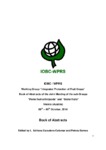Use este identificador para citar ou linkar para este item:
http://www.alice.cnptia.embrapa.br/alice/handle/doc/999325| Título: | Intraspecific divergence between Grapholitha molesta (Tortricidae, Lepidoptera) populations from Italy and Greece in relation to temperature. |
| Autoria: | DAMOS, P.  BONSIGNORE, C. P.   BOTTON, M.   AVTZIS, D. N.   |
| Afiliação: | MARCOS BOTTON, CNPUV. |
| Ano de publicação: | 2014 |
| Referência: | In: IOBC-WPRS WORKING GROUP "INTEGRATED PLANT PROTECTION IN FRUIT CROPS", SUB GROUPS "POME FRUIT ARTHROPODS" AND "STONE FRUITS", 2014, Vienna. Abstracts... Vienna: IOBC-WPRS, 2014. |
| Páginas: | p. 41 |
| Conteúdo: | Genetic changes contributing to phenotypic and phenological differences within or between species have been identified for a handful of traits, but the relationship between alleles underlying intraspecific polymorphism and interspecific divergence is largely unknown. Particularly for economically important insects macroscopic diagnosis and assessment of species boundaries and related population dynamics is often problematic because of the limited morphological and/or biological traits. In this work we attempt to compare temperature driven physiological responses of Grapholita molesta populations from different areas along with an initial phylogenetic analysis. To evaluate region-specific moth phenology patterns, we used the data sets of flights during two successive growth seasons (2011 and 2012). Population sizes of G. molesta moth phenology depended strongly on the particular location of research and model performance that were applied to predict population dynamics was less effective in predicting the related data sets. In addition, several individual from two populations (Italy and Greece) were screened with two mtDNA loci (761 bp and 627 bp in length) revealing the levels of intraspecific divergence within this species between different geographic regions. Beside that, however, DNA barcoding revealed that at least two species other than G. molesta were also attracted by the G. molesta lures. It was thus made evident that DNA-based approaches can shed more light into variation in phenology observed among populations of the same species. With that, more work is on the way, including a comprehensive population study and a rigorous sampling of many more geographical regions to offer a more robust explanation of intraspecific divergence. |
| Thesagro: | Genética Temperatura Fisiologia Filogenia DNA Dinâmica populacional |
| Palavras-chave: | Grapholitha molesta |
| Tipo do material: | Resumo em anais e proceedings |
| Acesso: | openAccess |
| Aparece nas coleções: | Resumo em anais de congresso (CNPUV)  |
Arquivos associados a este item:
| Arquivo | Descrição | Tamanho | Formato | |
|---|---|---|---|---|
| BottonCapa.pdf | 59,76 kB | Adobe PDF |  Visualizar/Abrir |









